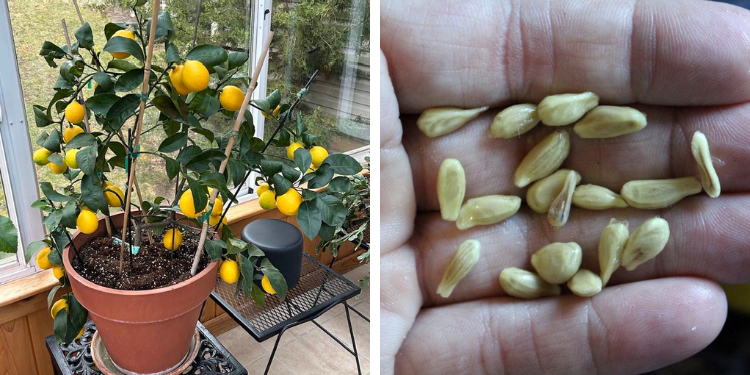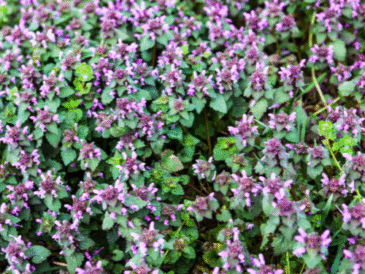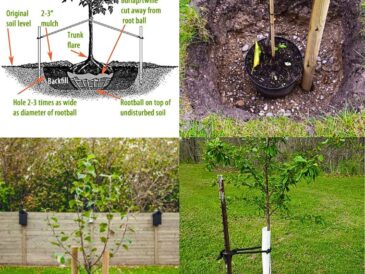You just enjoyed a tangy, refreshing lemon – but instead of tossing the seeds, you can use them to grow a living lemon tree.
This little project costs next to nothing, but the rewards can be huge: a beautiful, fragrant plant that can live for decades and possibly produce homegrown lemons.
Growing lemons from seeds isn’t complicated, but success depends on knowing exactly how to handle the seeds, encourage germination, and care for your plant over time.
Why Grow a Lemon Tree from Seed?
1. Budget-Friendly Gardening
Instead of buying an expensive nursery plant, you can start with seeds you already have from a lemon in your kitchen.
2. Long-Term Enjoyment
Lemon trees can live for decades with proper care. You could enjoy this plant for most of your life.
3. Aromatic & Decorative
Even if it never fruits, a lemon tree’s glossy green leaves and fragrant blossoms make it a beautiful indoor or patio plant.
4. Learning Experience
This project is an easy introduction to plant propagation, germination, and tree care – great for both beginners and children.
Step 1: Choosing the Right Lemon and Seeds
The quality of your tree begins with the quality of your seeds.
Best Options:
- Organic lemons (no growth-inhibiting chemicals).
- Fully ripe lemons (bright yellow, firm to the touch).
Avoid:
- Lemons that have been in cold storage for weeks (reduced seed viability).
- Green, underripe lemons (immature seeds).
Tip: Plan to plant your seeds immediately after removing them – citrus seeds lose germination power quickly if they dry out.
Step 2: Preparing Seeds for Germination
Lemon seeds have a slippery coating that can slow or prevent sprouting. Removing it can speed up germination.
How to Prepare:
- Slice lemon and remove seeds without cutting them.
- Rinse under lukewarm water to remove pulp.
- Rub gently between your fingers or in a paper towel to remove the mucilage.
- Optional: Soak in warm water for 12–24 hours to soften the seed coat.
Step 3: Two Proven Germination Methods
Method 1: Paper Towel Germination (Great for Monitoring Progress)
- Moisten (not soak) a paper towel.
- Place seeds inside, fold over, and seal in a zip-lock bag.
- Store in a warm, dark spot (70–80°F / 21–27°C).
- Check every 3–5 days for sprouts.
Pros: You can see exactly which seeds germinate.
Cons: Roots must be handled carefully when transplanting.
Method 2: Direct Planting (Lower Risk of Root Damage)
- Fill a small pot with a citrus-friendly, well-draining soil mix.
- Plant seeds about ½ inch deep.
- Water lightly and cover with a humidity dome or plastic wrap.
- Place in a warm, bright location until seedlings emerge.
Pros: Less root disturbance.
Cons: Can’t see germination progress.
Step 4: The Best Soil for Lemon Seedlings
Citrus trees thrive in well-aerated, nutrient-rich soil that drains well.
Recommended Mix:
- 40% potting soil
- 30% coarse sand or perlite
- 30% compost or aged manure
- Optional: Add a tablespoon of crushed eggshells for calcium.
Step 5: Light, Temperature, and Humidity
- Light: 10–12 hours daily. Use a grow light in winter.
- Temperature: Ideal range is 65–85°F (18–29°C).
- Humidity: Maintain around 50–60%. Indoors, use a pebble tray if air is dry.
Step 6: Watering and Feeding
- Watering: Keep soil lightly moist, allowing the top inch to dry between waterings. Avoid soggy conditions.
- Feeding: After seedlings develop 4–6 true leaves, start feeding every 4–6 weeks with a diluted liquid fertilizer. Switch to a high-nitrogen citrus fertilizer as the plant matures.
Step 7: Transplanting to Larger Pots
Once seedlings are 6–8 inches tall and have healthy roots:
- Choose a pot 2 inches wider than the current one.
- Remove gently to avoid damaging roots.
- Replant at the same depth, water, and keep in indirect light for a few days.
Step 8: Indoor vs. Outdoor Growing
Indoors:
- Best for cooler climates.
- Place near a south-facing window or under grow lights.
Outdoors:
- Ideal for USDA zones 9–11.
- Plant in full sun with shelter from strong winds.
Tip: Gradually harden off indoor plants before moving them outside for summer.
Step 9: Encouraging Faster Growth
Seed-grown lemon trees can take 5–15 years to produce fruit. To speed this up:
- Use a large pot to encourage root expansion.
- Keep growth steady with consistent watering and fertilizing.
- Prune regularly to encourage strong, upright growth.
- Graft your young tree onto mature citrus rootstock for quicker fruiting.
Step 10: Pruning for Strength and Shape
Prune to:
- Remove crossing or weak branches.
- Shape the tree for even growth.
- Improve air circulation to prevent fungal issues.
Step 11: Pest and Disease Prevention
Common pests: Aphids, spider mites, scale insects.
Natural solutions: Neem oil sprays, insecticidal soap, or simply wiping leaves with a damp cloth.
Fungal concerns: Overwatering is the main cause – ensure proper drainage.
Step 12: Winter Care for Lemon Trees
- Bring potted trees indoors before frost.
- Reduce watering during dormancy.
- Keep in a bright, cool location (around 60°F / 15°C).
Month-by-Month Lemon Tree Care Calendar
This guide works whether you’re growing your lemon tree indoors or outdoors (in suitable climates). Adjust slightly for your local weather conditions.
January – Rest & Monitor
- Keep the plant indoors in a bright, cool spot if in a cold climate.
- Reduce watering – only water when the top 1–2 inches of soil are dry.
- Check for pests such as scale insects or spider mites that thrive in dry indoor air.
- Avoid fertilizing during dormancy.
February – Early Prep
- Begin slightly increasing water if new growth appears.
- Inspect roots – if the plant is root-bound, prepare to repot next month.
- Rotate the plant weekly to ensure even light exposure.
March – Repot & Refresh
- Ideal time for repotting young trees into slightly larger pots.
- Replace top 2 inches of soil in older trees with fresh citrus mix.
- Start fertilizing with a balanced liquid citrus fertilizer every 4–6 weeks.
- Begin hardening off potted trees in mild climates by moving them outdoors for short periods.
April – Growth Boost
- Increase watering as temperatures rise and growth speeds up.
- Move potted trees outdoors (in frost-free areas) for full sun exposure.
- Begin regular pest inspections and apply neem oil if needed.
- Apply a slow-release fertilizer to encourage steady development.
May – Active Growth
- Keep soil consistently moist but never soggy.
- Pinch back overly long shoots to promote branching.
- In warmer climates, flowers may appear – ensure pollination by lightly shaking branches or using a small paintbrush.
- Protect from sudden temperature drops.
June – Flower & Fruit Set (in mature trees)
- Continue deep, consistent watering.
- Feed with a high-potassium fertilizer to support flower and fruit development.
- Mulch around the base of outdoor trees to retain moisture.
- Monitor for pests like aphids or whiteflies and treat promptly.
July – Summer Care
- Water deeply in the early morning before heat builds.
- Check potted trees daily for dryness in hot weather.
- Prune lightly to maintain shape and remove dead wood.
- If fruit is developing, thin overcrowded clusters to prevent branch strain.
August – Sun & Nutrition
- Keep up with consistent watering and feeding every 4 weeks.
- Shield potted trees from scorching midday sun with shade cloth if leaves show burn marks.
- Continue pest checks – citrus leaf miners are common this month.
September – Transition Month
- Reduce feeding slightly as growth slows.
- Begin moving potted trees indoors in cooler climates before nighttime temps drop below 50°F (10°C).
- Remove any fallen leaves or debris from around the base to prevent fungal issues.
October – Prepare for Rest
- Prune lightly after bringing plants indoors to control size and remove weak growth.
- Reduce watering – the plant will slow growth as days shorten.
- Maintain bright indoor lighting with grow lights if needed.
November – Winter Watch
- Keep soil barely moist.
- Ensure good air circulation indoors to prevent mold or mildew.
- Clean leaves with a damp cloth to remove dust and allow maximum light absorption.
December – Dormancy Period
- No feeding – allow the tree to rest.
- Water sparingly, just enough to prevent the root ball from drying out completely.
- Enjoy your lemon tree as an indoor decorative plant through the holiday season.
Pro Tip for Faster Fruiting
If your lemon tree is still young and you want blooms sooner, grafting onto mature lemon rootstock can cut the wait time in half.
This is best done in spring or early summer when the tree is actively growing.
Expert Trick: Multiply Your Lemon Tree Without Seeds
Once your first tree is healthy, use stem cuttings to create clones that grow faster than seeds.
How:
- Take 6–8 inch cuttings from fresh, healthy growth.
- Dip in rooting hormone.
- Plant in a sandy, well-draining mix and keep covered until roots develop (2–4 weeks).
Why it works: Cuttings are genetic copies of the parent, meaning they can flower and fruit sooner.
Common Mistakes to Avoid
- Letting seeds dry out before planting.
- Using heavy soil without drainage.
- Overwatering young seedlings.
- Not giving enough light during early growth.
Growing a lemon tree from seeds is a slow but deeply rewarding process. With fresh seeds, the right germination method, and consistent care, you can raise a strong, healthy tree.




